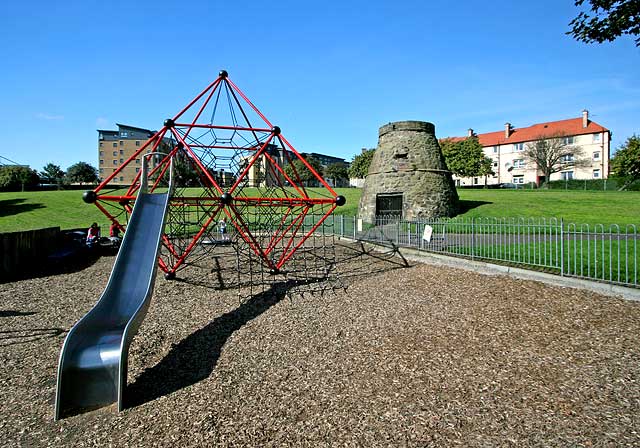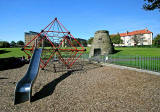|
Lochend Park
Lochend Park lies immediately north of Meadowbank Stadium, |
© Copyright: Peter Stubbs - please contact peter.stubbs@edinphoto.org.uk Photograph taken September 11, 2009
|
Question |
|
What is the old circular building on the grass behind he play park in this photo. So far as I can see, there is no plaque giving any name or description anywhere near the building. |
|
Answer 1 |
|
John Gifford's book 'The Buildings of Scotland - Edinburgh' gives the following description [p.662]: Doocot "Doocot: C16 beehive type, the large doorway and cylindrical top both later." |
|
Answer 2 |
|
John Stewart, Livingston, West Lothian, writes: Kiln "The building is not a doocot! It was used to wash the clothes of the 'well-to-do' at the time of the Great Plague" |
|
Answer 3 |
|
The RCAHMS (Royal Commission on the Ancient & Historic Monuments of Scotland) Canmore web site gives the following fuller description of the uses that have been made of this building: |
|
Archaeological Notes NT27SE 46 27633 74963 "This feature was originally a dovecot, built in the 16th century. It is circular, basal circumference 67'. The 3'7" thick walls are rubble; there is one string-course. Its fabric has been considerably altered, it is said for use as a kiln for disinfection during the plague of 1645. The top has been heightened with a masonry collar; a wide modern entrance has been cut out of the S side, but the original entrance, now built up, faced E. No nests remain, but the broken sills of 27 tiers may still be seen, so there must have been about 1,000 of them. In 1852, the building was used as a boat-house by the Royal Humane Society. It is now used as a store for implements used in the park.* " RCAHMS: 1951; A N Robertson 1945. |
|
Map The Canmore web site also mentions that the dovecot is depicted in a contemporary map of the 1560 siege of Leith. |
|
Today * The old dovecot / kiln appeared to be empty when I last saw it, in September 2009. |
|
Answer 4 |
|
Thank you to G M Rigg who wrote: |
|
Doocot 1970s "As Kids in the 1970s, we all referred to this building as the doocot. We had been told that it was where doves and doos were kept as a food source, many years ago, by the nuns and other church folk who owned the land and park in the past, and that it was connected to the Manse. The Manse is situated by the roundabout at the top of Marionville Drive. A road now cuts through the land between the Manse and the park. They would not have had the areas separated by a road - would they ? " G M Rigg, Edinburgh. Message posted in EdinPhoto guest book: October 29, 2009 |
|
Answer 5 |
|
Thank you to George T Smith who wrote: |
|
Rebus Story Lochend Doocot? "I recently read Ian Rankin's 'Mortal Causes' (a Rebus story) in paperback. The front cover has what looks like the Lochend doocot, taken from a different angle. Most doocots look alike, of course. I remember a large one in Corstorphine, near the old Parish Church, I think. I never could understand why there was such an interest in housing/breeding pigeons in the 15-16th century - small eggs and lean pickings if the pigeons were eaten. Though I have seen literary references to eating pigeon which suggests they were a delicacy." George T Smith, Nanaimo, Vancouver Island, British Columbia, Canada: November 5, 2009 |
|
George T Smith sent another email, a few hours later, saying: |
|
Rebus Story Not Lochend Doocot "After another look at Rebus' book cover, I now think it is some other doocot; certainly not Corstorphine which appears to be akin to a gas holder!" George T Smith, Nanaimo, Vancouver Island, British Columbia, Canada: November 5, 2009 |
|
Answer 6 |
|
Thank you to Danny Callaghan who wrote: |
|
Pigeons "Pigeon breast are lovely and two breasts are an ample meal. Only the rich were allowed to keep pigeons in doocots. This was before the days of refrigeration when the only real option to keep meat fresh was to salt it. So this is how the rich had a supply of fresh meat. Only wealthy landowners were allowed by statute to have a doocot. I have never quite understood why sheep and cattle could not be slaughtered throughout the winter, unless it was because the winters were colder and winter fodder was too expensive. The farmers used to hate the pigeons as they would eat all their crops." Danny Callaghan, Falkirk, Stirlingshire, Scotland: November 5, 2009 |
|
Edinburgh Parks |
|

